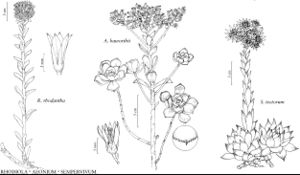Sempervivum
Sp. Pl. 1: 464. 1753.
Gen. Pl. ed. 5, 209. 1754 ,.
Herbs, perennial, monocarpic, not viviparous, 1–6 dm, pubescent or glabrous. Stems erect, (compressed), not branched, succulent. Leaves persistent, forming basal rosette, alternate, sessile, not connate basally; blade oblanceolate to obovate, laminar to semiterete, 1.5–4(–6) cm, succulent, base not spurred, margins ciliate; veins not conspicuous. Inflorescences terminal cymes. Pedicels absent or to 5 mm. Flowers erect, 8–16-merous; sepals ± connate basally, all alike; petals spreading, distinct, pink to purple; calyx and corolla not circumscissile in fruit; nectaries quadrate; stamens 2+ times as many as sepals; filaments free; pistils erect, connivent; ovary base truncate; styles nearly as long as ovary. Fruits erect. Seeds (brown), ellipsoid, ribbed.
Distribution
Introduced; Europe, Asia.
Discussion
Species 40–100 (1 in the flora).
Taxonomic circumscription of Sempervivum has been problematic since Linnaeus described the first six species. As few as 40 and as many as 100 taxa have been assigned to the genus, and names given to forms, cultivars, and hybrids. The most recent complete treatment, by H. ’t Hart et al. (2003), provides an excellent summary of the genus and taxonomic synonyms.
